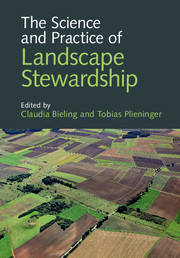Book contents
- The Science and Practice of Landscape Stewardship
- The Science and Practice of Landscape Stewardship
- Copyright page
- Contents
- Contributors
- Preface
- 1 The Emergence of Landscape Stewardship in Practice, Policy and Research
- Part I Foundations of Landscape Stewardship
- Part II Landscape Stewardship on the Ground
- 6 Organising Adaptive and Collaborative Landscape Stewardship on Farmland
- Case 5 Arbratatouille – A Participative Project Updating Agroforestry Techniques
- 7 Forest Landscape Stewardship for Functional Green Infrastructures in Europe's West and East
- Case 6 Wild Birds in Traditional Orchards – Testing Strategies for Biodiversity Conservation
- 8 The Future of the Past
- Case 7 The Whole Village Project – Saxon Village Restoration in Rural Romania
- 9 Landscape Stewardship in Wind Energy Conflicts
- Case 8 The Simmern Solidarity Pact – Reconciling Income Imbalances Between Villages
- 10 Synergies Between Tourism, Outdoor Recreation and Landscape Stewardship
- Case 9 Bun Tschlin – Linking Identity, Community and Landscape
- 11 Managed, Mended, Supported
- Case 10 Landowners on Læsø – A Cooperative Approach to Landscape Management
- 12 Stewardship in Urban Landscapes
- Case 11 Urban Green Infrastructure in Vienna – Nature-Based Solutions to Enhancing Quality of Life
- 13 Landscape Stewardship and Hunting, Angling and Gathering Wild Products
- Case 12 ØsterGRO Rooftop Farm – Community Supported Agriculture in the Middle of Copenhagen
- 14 Marine and Coastal Ecosystem Stewardship
- Case 13 The Firth of Clyde Marine Spatial Plan – Synergies and Trade-Offs in a Diverse Coastal Environment
- 15 Landscape Stewardship for Rangelands
- Case 14 Herding Schools in France – Supporting Traditional Landscape Management Techniques in Modern Times
- Part III Visions Towards Landscape Stewardship
- Index
- References
9 - Landscape Stewardship in Wind Energy Conflicts
Between Cultural Myths and Interests
from Part II - Landscape Stewardship on the Ground
Published online by Cambridge University Press: 05 July 2017
- The Science and Practice of Landscape Stewardship
- The Science and Practice of Landscape Stewardship
- Copyright page
- Contents
- Contributors
- Preface
- 1 The Emergence of Landscape Stewardship in Practice, Policy and Research
- Part I Foundations of Landscape Stewardship
- Part II Landscape Stewardship on the Ground
- 6 Organising Adaptive and Collaborative Landscape Stewardship on Farmland
- Case 5 Arbratatouille – A Participative Project Updating Agroforestry Techniques
- 7 Forest Landscape Stewardship for Functional Green Infrastructures in Europe's West and East
- Case 6 Wild Birds in Traditional Orchards – Testing Strategies for Biodiversity Conservation
- 8 The Future of the Past
- Case 7 The Whole Village Project – Saxon Village Restoration in Rural Romania
- 9 Landscape Stewardship in Wind Energy Conflicts
- Case 8 The Simmern Solidarity Pact – Reconciling Income Imbalances Between Villages
- 10 Synergies Between Tourism, Outdoor Recreation and Landscape Stewardship
- Case 9 Bun Tschlin – Linking Identity, Community and Landscape
- 11 Managed, Mended, Supported
- Case 10 Landowners on Læsø – A Cooperative Approach to Landscape Management
- 12 Stewardship in Urban Landscapes
- Case 11 Urban Green Infrastructure in Vienna – Nature-Based Solutions to Enhancing Quality of Life
- 13 Landscape Stewardship and Hunting, Angling and Gathering Wild Products
- Case 12 ØsterGRO Rooftop Farm – Community Supported Agriculture in the Middle of Copenhagen
- 14 Marine and Coastal Ecosystem Stewardship
- Case 13 The Firth of Clyde Marine Spatial Plan – Synergies and Trade-Offs in a Diverse Coastal Environment
- 15 Landscape Stewardship for Rangelands
- Case 14 Herding Schools in France – Supporting Traditional Landscape Management Techniques in Modern Times
- Part III Visions Towards Landscape Stewardship
- Index
- References
Summary
- Type
- Chapter
- Information
- The Science and Practice of Landscape Stewardship , pp. 167 - 181Publisher: Cambridge University PressPrint publication year: 2017
References
- 2
- Cited by

